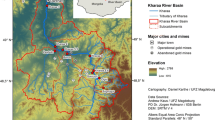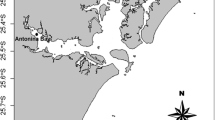Abstract
Objective
The aim of this study was to evaluate the levels of cadmium and lead in edible tissue of Mytella charruana and Mugil curema from three coastal lagoons (Altata Ensenada del Pabellón, AEP; Urías, URI; and Teacapán, TEA) of Sinaloa (NW of Mexico) during an annual cycle, to compare maximum permissible levels (MPLs) of with legal limits of cadmium and lead, and to assess potential risk for consumers.
Methods
Samples of charry mussel (M. charruana) and white mullet (M. curema) were collected every two months between July 2005 and July 2006 in three of the main lagoon systems in the state of Sinaloa (NW Mexico): Altata-Ensenada del Pabellón (AEP), Urías (URI) and Teacapán (TEA), which represent different pollution.
Results
The range of mean levels in the studied lagoons were as follows: in M. charruana Cd 0.064 to 0.222 and Pb 0.206 to 0.482 μg g-1 ww, respectively and in M. curema Cd 0.003 to 0.018 and Pb 0.013 to 0.019 μg g-1 ww, respectively. Taking into account national and international regulations, the Cd and Pb levels detected in M. curema apparently do not pose a risk for human health. Nonetheless, for M. charruana the scenario is different, some levels of Cd in TEA surpassed maximum permissible levels (MPL’s) of European Commission (EC) and Codex regulations and on the other hand, Pb levels in AEP rather than URI surpassed MPLs of national and international regulations.
Conclusion
Although some levels exceed legal limits, risks for human health are diluted because EDI - of Cd and Pb - via consumption of edible tissue of fish were far below the provisional permissible tolerable daily intake (PTDI) values established by FAO/WHO. However, this situation is different if we taking into account, different patterns of consumption in mussels, few EDI values exceed the established levels of PTDI.
Similar content being viewed by others
References
Becker, W., Darnerud, P. O. & Petersson-Grawé, K. Risks and Benefits of Fish Consumption: A Risk-Benefit Analysis Based on the Occurrence of Dioxin/PCB, Methyl Mercury, n-3 Fatty Acids and Vitamin D in Fish, https://doi.org/www.livsmedelsverket.se/globalassets/publikationsdatabas/rapporter/2007/2007_12_risks_and_benefits_of_fish_consumption.pdf (2007).
World Health Organization & Food and Agriculture Organization of the United Nations. Report of the Joint FAO/WHO Expert Consultation on the Risks and Benefits of Fish Consumption, http://www.fao.org/docrep/ 015/ba0136e/ba0136e00.htm (2011).
FAOSTAT (Food and Agriculture Organization of the United Nations). Food Supply -Livestock and fish equivalent. Online version, available in https://doi.org/fenixservices.fao.org/faostat/static/bulkdownloads/FoodSupply_LivestockFish_E_All_Data_(Normalized).zip (2017).
CONAPESCA (Comisión Nacional de Acuacultura y Pesca). Anuario Estadístico de Acuacultura y Pesca, https://doi.org/www.conapesca.gob.mx/work/sites/cona/dgppe/2014/anuario_estadistico_de_acuacultura_y_pesca_2014.pdf (2014).
Gutiérrez-Galindo, E. A., Villaescusa-Celaya, J. A. & Arreola-Chimal, A. Bioacumulación de metales en mejillones de cuatro sitios selectos de la región costera de Baja California. Cienc. Mar. 25, 557–578 (1999).
Pereira-Santos, L. F., Sitonio-Trigueiro, I. N., Azevedo-Lemos, V., da Nóbrega-Furtunato, D. M. & Vieira-Cardoso, R. D. C. Assessment of cadmium and lead in commercially important seafood from São Francisco Do Conde, Bahia, Brazil. Food Control 33, 193–199 (2013).
Alexander, D. E. in Encyclopedia of Environmental Science (eds Alexander, D. E. & Fairbridge, R. W.) 43–44 (Springer: Dordrecht, Netherlands, 1999).
Frías-Espericueta, M. G. et al. The metal content of bivalve molluscs of a coastal lagoon of NW Mexico. B. Environ. Contam. Tox. 80, 90–92 (2008).
Ruelas-Inzunza, J., Green-Ruiz, C., Zavala-Nevárez, M. & Soto-Jiménez, M. Biomonitoring of Cd, Cr, Hg and Pb in the Baluarte River basin associated to a mining area (NW Mexico). Sci. Total Environ. 409, 3527–3536 (2011).
Mashroofeh, A., Bakhtiari, A. R., Pourkazemi, M. & Rasouli, S. Bioaccumulation of Cd, Pb and Zn in the edible and inedible tissues of three sturgeon species in the Iranian Coastline of the Caspian Sea. Chemosphere 90, 573–580 (2013).
Sneddon, J. & Thibodeaux, C. A. in Safety Analysis of Foods of Animal Origin (eds Nollet, L. M. L. & Toldrá, F) 641–661 (Taylor and Francis Group, LLC, Boca Raton, FL, 2011).
Ersoy, B. & Çelik, M. Essential elements and contaminants in tissues of commercial pelagic fish from the Eastern Mediterranean Sea. J. Sci. Food Agric. 89, 1615–1621 (2009).
ATSDR (Agency for Toxic Substances and Disease Registry). Priority List of Hazardous Substance, https://doi.org/www.atsdr.cdc.gov/spl/ (2011).
Wu, P., Li, C., Chen, J., Zheng, C. & Hou, X. Determination of cadmium in biological samples: an update from 2006 to 2011. Appl. Spectrosc. Rev. 47, 327–370 (2012).
Moulis, J. M. & Thévenod, F. New perspectives in cadmium toxicity: an introduction. Biometals 23, 763–768 (2010).
Li, Y. et al. Cadmium accumulation and metallothionein biosynthesis in cadmium-treated freshwater mussel Anodonta woodiana. PLoS ONE 10, doi:10.1371/journal. pone.0117037 (2015).
Pattee, O. H. & Pain, D. J. in Handbook of Ecotoxicology (eds Hoffman, D. J., Rattner, B. A., Burton, G. A. & Cairns, J.) 373–408 (CRC Press LLC, Boca Raton, FL, 2003).
Zamora-Arellano, N. Y., Ruelas-Inzunza, J., García-Hernández, J., Ilizaliturri-Hernández, C. A. & Betancourt-Lozano, M. Linking fish consumption patterns and health risk assessment of mercury exposure in a coastal community of NW Mexico. Hum. Ecol. Risk Assess. 23, 1505–1521 (2017).
Olmedo, P. et al. Determination of toxic elements (mercury, cadmium, lead, tin and arsenic) in fish and shellfish samples. Risk assessment for the consumers. Environ. Int. 59, 63–72 (2013).
Aydin-Onen, S., Kucuksezgin, F., Kocak, F. & Açik, S. Assessment of heavy metal contamination in Hediste diversicolor (O.F. Müller, 1776), Mugil cephalus (Linnaeus, 1758), and surface sediments of Bafa Lake (Eastern Aegean). Environ. Sci. Pollut. Res. 22, 8702–8718 (2015).
Coan, E. V. & Valentich-Scott, P. in Bivalve Seashells of Tropical West America: Marine Bivalve Mollusks from Baja California to Northern Peru 1st Edn (Santa Barbara Museum of Natural History Monograpfs 6, Studies in Biodiversity 4, 2012).
U.S. Environmental Protection Agency. SW-846 Test Method 3052: Microwave assisted acid digestion of siliceous and organically based matrices, online version, available on: https://doi.org/www.epa.gov/sites/production/files/2015-12/documents/3052.pdf (1996).
Cadena-Cárdenas, L., Méndez-Rodríguez, L., Zenteno-Savín, T., García-Hernández, J. & Acosta-Vargas, B. Heavy metal levels in marine mollusks from areas with, or without, mining activities along the Gulf of California, Mexico. Arch. Environ. Con. Tox. 57, 96–102 (2009).
Streit, B. in Fish Ecotoxicology (eds Braunbeck, T., Hinton, D. E. & Streit, B.) 353–387 (Birkhaeuser Verlag, Basel, Switzerland, 1998).
World Health Organization & Food and Agriculture Organization of the United Nations. Evaluation of certain food additives and contaminants: seventy-third report of the Joint FAO/WHO Expert Committee on Food Additives (JECFA 1956–2011), https://doi.org/apps.who.int/iris/bitstream/handle/10665/44515/WHO_TRS_960_eng.pdf;jsessionid=27C7FAA4C3C8ED3170077170025B 27A5?sequence=1 (2011).
Orisakwe, O. E., Nduka, J. K., Amadi, C. N., Dike, D. O. & Bede, O. Heavy metals health risk assessment for population via consumption of food crops and fruits in Owerri, South Eastern, Nigeria. Chem. Cent. J. 6, 77 (2012).
Ruelas-Inzunza, J., Hernández-Osuna, J. & Páez-Osuna, F. Total and organic mercury in ten fish species for human consumption from the Mexican Pacific. B. Environ. Contam. Tox. 86, 679–683 (2011).
Tirado-Escovar, D. Y. Mercurio en el pez dorado Corypfaena hippurus de la costa del sur de Sinaloa: distribución y transferencia trófica. Disertation, Universidad Autónoma de México [in spanish] (2013).
Osuna-López, J. I. et al. Cd, Pb and organochlorine pesticides of Mytella strigata (Pelecypoda: Mytilidae) of six coastal lagoons of NW Mexico. Bol. Invest. Mar. Cos. 38, 233–239 (2009).
Ruelas-Inzunza, J. & Páez-Osuna, F. Trophic distribution of Cd, Pb, and Zn in a food web from Altata-Ensenada del Pabellón Subtropical Lagoon, SE Gulf of California. Arch. Environ. Con. Tox. 54, 584–596 (2008).
Szefer, P. et al. Distribution and association of trace metals in soft tissue and byssus of Mytella strigata and other benthal organisms from Mazatlan harbour, mangrove lagoon of the Northwest Coast of Mexico. Environ. Int. 24, 359–374 (1998).
Ruelas-Inzunza, J. & Páez-Osuna, F. Comparative bioavailability of trace metals using three filter-feeder organisms in a subtropical coastal environment (Southeast Gulf of California). Environ. Pollut. 107, 437–444 (2000).
Norma Oficial Mexicana 242 (NOM-242-SSA1-2009 Productos y servicios. Productos de la pesca frescos, refrigerados, congelados y procesados. Especificaciones sanitarias y métodos de prueba [in spanish] (2009).
Australia New Zealand Food Standards Code -Standard 1.4.1 -Contaminants and Natural Toxicants, https://doi.org/www.legislation.gov.au/Details/F2011C00542/473861a6-39bd-4401-9465-568d7e113af8 (2016).
European Commission Regulation (EC) No.1881/2006 setting maximum levels for certain contaminants in foodstuffs, https://doi.org/eur-lex.europa.eu/legal-content/ES/TXT/PDF/?uri=CELEX:32006R1881&from=EN (2006).
CCFAC (Codex Committee on Food Additives and Contaminants). Report of the 32nd session of the Codex Committee on Food Additives and Contaminants: Joint FAO/WHO Food Standards Programme (Thirty-fourth Session), https://doi.org/www.fao.org/tempref/codex/Reports/Alinorm01/al01_12e.pdf (2001).
National Standard of the People’s Republic of China: National Food Safety Standard Maximum Levels of Contaminants in Food (GB 2762–2012), https://doi.org/www.seafish.org/media/publications/china_max_levels_of_contaminants_in_food.pdf (2013).
Páez-Osuna, F. et al. Concentrations of selected trace metals (Cu, Pb, Zn), organochlorines (PCBs, HCB) and total PAHs in mangrove oysters from the pacific coast of Mexico: an overview. Mar. Pollut. Bull. 44, 1303–1308 (2002).
Gil-Manrique, B. et al. Cadmium and lead concentrations in hepatic and muscle tissue of demersal fish from three lagoon systems (SE Gulf of California). Environ. Sci. Pollut. Res. 24, 12927–12937 (2017).
Ruelas-Inzunza, J., Páez-Osuna, F. & García-Flores, D. Essential (Cu) and nonessential (Cd and Pb) metals in ichthyofauna from the coasts of Sinaloa state (SE Gulf of California). Environ. Monit. Assess. 162, 251–263 (2010).
Frías-Espericueta, M. G. et al. Cadmium, copper, lead, and zinc in Mugil cephalus from seven coastal lagoons of NW Mexico. Environ. Monit. Assess. 182, 133–139 (2011).
Frías-Espericueta, M. G. et al. Metal contents of four commercial fish species of NW Mexico. B. Environ. Contam. Tox. 85, 334–338 (2010).
EC (2008) European Commission Regulation (EC) No.629/2008 setting maximum levels for certain contaminants in foodstuffs, https://doi.org/www.fsai.ie/uploadedFiles/commission_regulation_ec_no_629_2008.pdf (2008).
Codex Committee on Food Additives and Contaminants (CCFAC) (2001b) Codex Committee on Food Additives and Contaminants (CCFAC), 2001-Comments Submitted on the Draft Guideline Level and Proposed Draft Maximum Levels for Cadmium: Joint FAO/WHO Food Standards Programme (Thirty-third Session) CX/FAC 01/28, The Hague, The Netherlands, 12–16 March 2001.
Priya, S. L. et al. Bioaccumulation of heavy metals in mullet (Mugil cephalus) and oyster (Crassostrea madrasensis) from Pulicat Lake, South East Coast of India. Toxicol. Ind. Health 27, 117–126 (2011).
Páez-Osuna, F. & Osuna-Martínez, C. C. Bioavailability of cadmium, copper, mercury, lead, and zinc in subtropical coastal lagoons from the southeast gulf of California using mangrove oyster (Crassostrea corteziensis and Crassostrea palmula). Arch. Environ. Con. Tox. 68, 305–316 (2015).
Ruiz-Ramírez, S. et al. Aspectos reproductivos de la lisa Mugil curema (Mugiliformes: Mugilidae) en la laguna costera de Barra de Navidad, Jalisco, México. Lat. Am. J. Aquat. Res. 45, 443–456 (2017).
García-Gasca, A. et al. The white mullet (Mugil curema) as biological indicator to assess environmental stress in tropical coastal lagoons. Environ. Monit. Assess. 188, 688–702 (2016).
Rajkumar, J. S. I., John-Milton, M. C. & Arockia-Rita, J. J. Bioaccumulation of some heavy metals Cd, Cu, Pb and Zn in Mugil cephalus, Perna viridis and Penaeus monodon. Int. J. Adv. Res. Biot. 1, 5–9 (2012).
Yi, Y., Yang, Z. & Zhang, S. Ecological risk assessment of heavy metals in sediment and human health risk assessment of heavy metals in fishes in the middle and lower reaches of the Yangtze River basin. Environ. Pollut. 159, 2575–2585 (2011).
Author information
Authors and Affiliations
Corresponding author
Rights and permissions
About this article
Cite this article
Astorga-Rodríguez, J.E., Martínez-Rodríguez, I.E., García-de la Parra, L.M. et al. Lead and Cadmium Levels in Mussels and Fishes from Three Coastal Ecosystems of NW Mexico and Its Potential Risk due to Fish and Seafood Consumption. Toxicol. Environ. Health Sci. 10, 203–211 (2018). https://doi.org/10.1007/s13530-018-0365-1
Received:
Revised:
Accepted:
Published:
Issue Date:
DOI: https://doi.org/10.1007/s13530-018-0365-1




